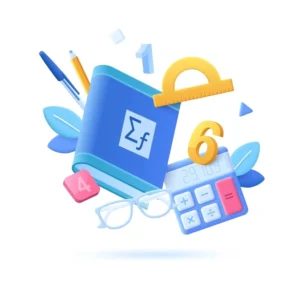The acknowledgement to question – What does Product mean in Math? is that, In mathematics the term product refers to the result of multiplying two or more numbers together.
Example:
If you multiply 4 and 5, the product is:
4 x 5 = 20
Here, 20 is the product.
Key Points to Remember:
- The numbers being multiplied are called factors.
- The answer you get after multiplying is the product.
- For example, in 6 x 3 = 18 , 6 and 3 are factors, and 18 is the product.
Why is it Important?
The concept of product is fundamental in mathematics, especially in arithmetic, algebra, and problem-solving. It helps in calculating areas, solving equations, and much more.
What Does Product Mean in Math?
In math, the product is the answer you get when you multiply two or more numbers together.
So the answer to question, what does product mean in math? is Multiplication which is one of the basic math operations, and the product is the result of multiplication.
Basic Example:
If you multiply 3 × 7 = 21, then:
- 3 and 7 are called factors.
- 21 is the product.
More Examples:
- 4 × 5 = 20 → Product is 20.
- 6 × 9 = 54 → Product is 54.
- 3 × 14 = 42 → Product is 42.
- 8 × 7 = 56 → Product is 56
- 13 × 4 = 52 → Product is 52
Multiplying Negative Numbers
- Positive × Negative = Negative
- Example: 5 × (-3) = -15 (Product is negative when one factor is negative)
- Negative × Negative = Positive
- Example: (-4) × (-2) = 8 (Product is positive when both factors are negative)
Properties of Multiplication
-
Commutative Property
The order of multiplication does not change the product.
Example,
4 x 5 = 20 and 5 x 4 = 20.
-
Associative Property
The way numbers are grouped in multiplication does not change the product.
Example
(2 x 3) x 4 = 2 x (3 x 4) = 24 .
-
Distributive Property
Multiplying a number by a sum is the same as multiplying each addend separately and then adding the products.
Example,
3 x (4 + 5) = 3 x 4 + 3 x 5 = 12 + 15 = 27 .
-
Identity Property of Multiplication
Any number multiplied by 1 remains the same.
Example,
7 x 1 = 7.
-
Zero Property of Multiplication
Any number multiplied by 0 gives a product of 0.
Example,
6 x 0 = 0.
Where Do We Use Product in Math?
So apart from What Does Product Mean in Math, let us also have a look at where do we use product in mathematics,
- Algebra: When multiplying letters (variables), we write them together.
Example: x × y = xy - Geometry: Used to find area.
Example: Area of a rectangle = length × width - Exponents: When multiplying the same base, add the exponents.
Example: x² × x³ = x⁵
Real-Life Uses of Product
- Buying multiple items (e.g., 3 apples at $2 each → 3 × 2 = $6).
- Finding the area of a floor, wall, or land.
- Counting total items in groups, like in packaging.
Common Mistakes to Avoid
Mixing up multiplication and addition
Forgetting to handle negative signs correctly.
Multiplying by 1 doesn’t change a number, but multiplying by 0 always gives 0.
More Concepts on What does Product mean in Math?
The product is the result of multiplying two or more numbers together. For different categories of numbers there’s a classification for the result of multiplying.
More Examples of What does Product mean in Math?
Let’s explore this concept with simple explanations and few more examples.
(I)Multiplying Decimals
When you multiply decimals, the product is the answer you get.
For example, multiplying 0.5 by 0.4 gives 0.20.
(II)Multiplying Fractions
To find the product of fractions:
- Multiply the top numbers (numerators).
- Multiply the bottom numbers (denominators).
For example, multiplying 1/2 by 3/4 results in (1×3) / (2×4) = 3/8.
(III)Multiplying Mixed Numbers
First, convert mixed numbers into improper fractions, then multiply.
For example, 1 1/2 × 2 1/3 converts to improper fractions as 3/2 × 7/3.
Multiplying them results in 21/6, which simplifies to 3.5.
(IV)Multiplying Multiple Numbers
You can multiply more than two numbers at once.
For example, multiplying 2, 3, and 4 results in 2 × 3 × 4 = 24.

Word Problems on What does Product mean in Math?
A box has 8 rows of 6 apples each. To find the total apples, multiply 8 by 6 to get 48 apples.
Similarly, A car which moves at a speed of 60 miles per hour. In 5 hours, it will travel 60 × 5 = 300 miles.
Visualizing Product
Think of multiplication as arranging objects in rows and columns.
For example, a 3×4 grid has 3 rows and 4 columns, meaning 3 × 4 = 12 items.
Related Concepts |
|---|
|
Factors are numbers that can be multiplied to get another number. For example, 2 and 5 are factors of 10 because 2 × 5 = 10. |
|
Multiples are numbers you get when you multiply by whole numbers. For example, multiples of 3 are 3, 6, 9, 12, and so on. |
|
The Greatest Common Factor (GCF) is the largest factor two numbers share. For example, the GCF of 12 and 18 is 6 because 6 is the biggest number that divides both. |
|
The Least Common Multiple (LCM) is the smallest multiple two numbers share. For example, the LCM of 4 and 6 is 12 because 12 is the smallest number both 4 and 6 can divide into. |
Common Questions About Product
Is the product always positive?
- No!
- Multiplying two negative numbers results in a positive product. For example, -2 × -3 = 6.
- Multiplying a positive and a negative number results in a negative product. For example, 2 × -3 = -6.
What is the product of prime numbers?
- Prime numbers have only two factors: 1 and itself.
- For example, the product of the prime numbers 2, 3, and 5 is 2 × 3 × 5 = 30.
Easy Trick to Remember
Use this phrase: “Please Multiply Now!”
This helps remind you that the product means to multiply.
Understanding Factorization in Simple Terms
Diving more in the acknowledgement of what does product mean in math, lets also explore some of the related concepts.
What is Factorization?
Factorization is the process of breaking a number into smaller numbers that multiply together to form the original number. These smaller numbers are called factors.
Example:
Let’s take 12 as an example. The numbers that multiply to make 12 are:
- 2 × 6 = 12
- 3 × 4 = 12
So, the factors of 12 are 2, 3, 4, and 6.
Prime Factorization
This is a special type of factorization where we break a number into only prime numbers (numbers that cannot be divided further, like 2, 3, 5, 7, etc.).
Example: Prime Factorization of 36
We break 36 into prime numbers:
- 36 = 2 × 18
- 18 = 2 × 9
- 9 = 3 × 3
So, the prime factorization of 36 is:
2 × 2 × 3 × 3 (or written as 2² × 3²).
Why is Factorization Useful?
So here are the factors which proves to be useful for the related concepts of what does product mean in math,
Finding the Greatest Common Factor (GCF):
Helps simplify fractions by dividing the numerator and denominator by the largest common factor.
Calculating the Least Common Multiple (LCM):
Helps find a common denominator for adding and subtracting fractions.
Solving Algebraic Equations:
Used in algebra to break down expressions and solve equations.
Example: x² + 5x + 6 can be rewritten as (x + 2)(x + 3) = 0 to find solutions for x.
Connection Between Product and Factorization
If you know the product (the result of multiplication), you can use factorization to break it into smaller parts. This makes solving math problems much easier!
Fun Fact:
The word “product” comes from Latin “productum”, meaning “something produced”—just like multiplication produces a new number!
Some Famous Math Platforms
Delta Math
Delta Math is a website that helps students practice math by providing interactive exercises and assignments. It covers many topics, from basic math to advanced calculus. Students get instant feedback and step-by-step solutions to help them learn.
Hooda Math
Hooda Math is a free website with fun math games. It includes puzzles, escape games, and logic challenges that make learning math enjoyable. These games help students improve their problem-solving skills while reinforcing math concepts.
99 Math
99 Math is an online game where students compete in real-time math challenges. Teachers often use it in classrooms to make learning fun and help students improve their math speed and accuracy through friendly competition.

Mitolyn I really like reading through a post that can make men and women think. Also, thank you for allowing me to comment!